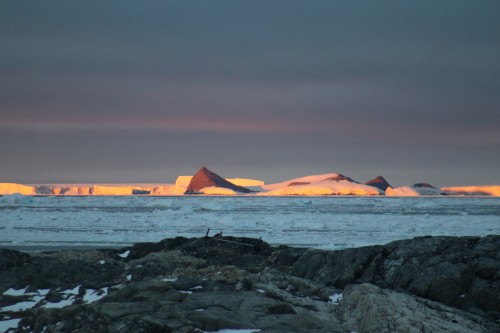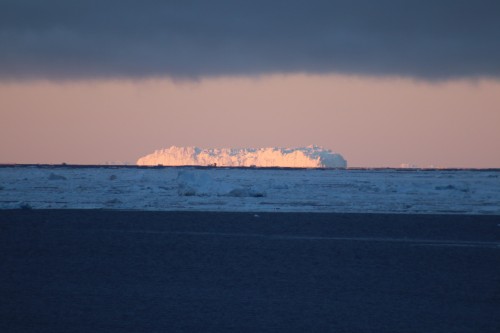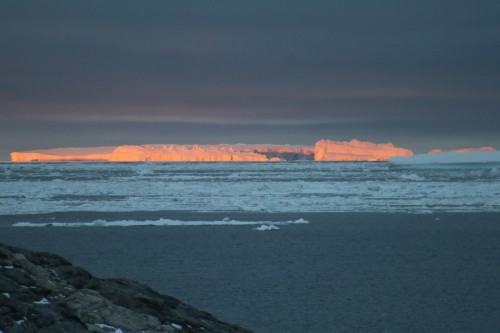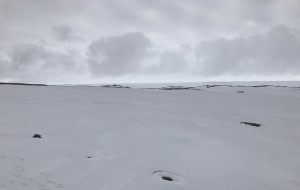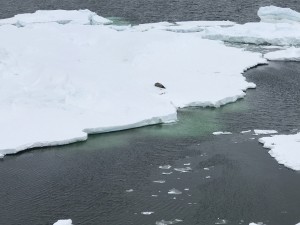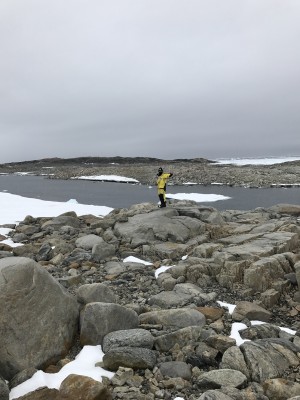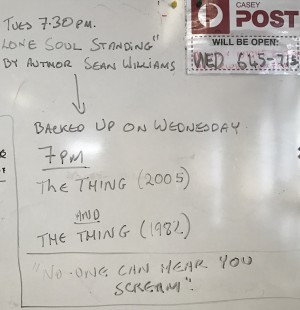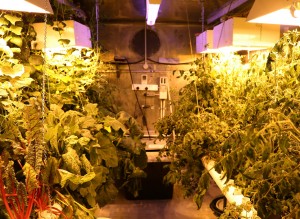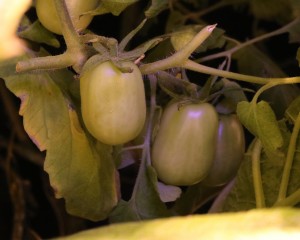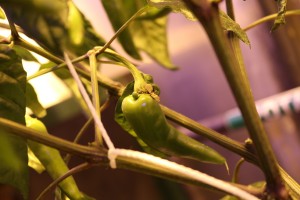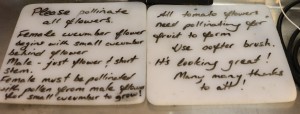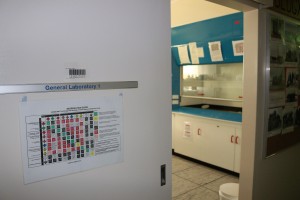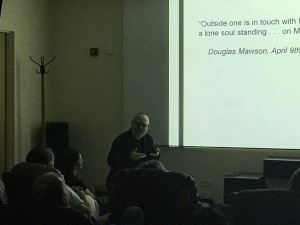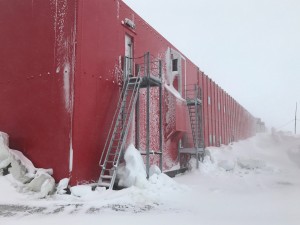The Adventures of AntarcticaSean Part Four: Aurora #1
Continuing from Part Three: “Adventure”
Monday
At 5.30am, I hear Johan leave the hut to go to the toilet. There’s a procedure we must all follow: no one goes to the loo without telling someone else. I guess people have got into trouble that way, going out alone–and what a terrible way to die that would be!
That’s not what happens tonight. A few minutes later, Johan returns to whisper to me and anyone else awake that the aurora australis is visible outside.
I’m out of my sleeping bag and into my boots quicker than you can say “wildest dream come true”. I never dared hope I’d be this lucky.
It’s dark outside, the first time I’ve really experienced the night in Antarctica. There’s a smear of yellow dawnlight to the east. Only a handful of stars are visible, not constellations I recognise.
And there it is, a faint ribbon of blue-ish purple-ish light draped lazily across the sky, rippling at its rightmost edge, like a lace curtain catching a breeze.
I crane my neck back to take it all in.
The aurora is gorgeous, but no way am I going back inside to get my camera. This is just for me, and for my friends gathering on the Wilkes Hilton verandah, an icy metal walkway just outside the door.
Later, I don’t remember any of us saying anything, but I probably babble about how amazing it all is. That’s the kind of thing I’m prone to, breaking with words a perfectly good silence.
Our aurora lasts for five minutes or so, then fades to nothing. The night closes in on us. It’s bitterly cold. None of us are dressed for extended exposure. One by one, my friends slip back inside to return to their beds.
Me, I grab my pee bottle and coat and make the trek to the toilet with the best view in the world. The view at that moment is entirely in my mind. I still can’t believe it: I saw the aurora australis!
By the time I finish and return to the Hilton, it has returned, exactly the same as before. I agonise over whether to call the others back out, but the air is no warmer and the display could last only seconds. It could be gone before they even get out of bed.
I stand alone, watching until it fades away for good. It takes five minutes. There’s a feeling I can’t quite put into words, as though Antarctica has properly introduced itself to me now. Not welcomed: I belong to an alien species, like the flies in the sewage tanks. But . . . noticed. Acknowledged. Addressed.
Of course, this is entirely in my mind. I am to Antarctica as those flies are to me. It’s not my friend. It’ll kill me as impersonally as bug-zapper if I push my luck, just like so many expeditioners have been killed in the past. Antarctic is beautiful, but it is also deadly. One state coexists with the other in uneasy harmony, with humanity caught in the middle.
I go back inside to get back into bed, but there’ll be no more sleep for me tonight. I lie awake feeling this incredible land wake up around me and my seven companions, already wondering how I can possibly capture this experience in words.
People start stirring and then suddenly we’re up and moving. No breakfast. We aim to be back at Casey by around 8am. Civilisation is looming again, but of course it’s all relative down here. The hut wasn’t anywhere near as primitive as Mawson et al lived in a century ago. It even picked up a hint of wi-fi from the station, allowing us to text home if we wanted to. I’ll confess I did, just to let my wife know I was still alive. (Not that she was in any doubt about that.) Over Casey itself looms the larger promise of our return to Australia.
I’m halfway into my Antarctic adventure, but the exact endpoint is uncertain. The C17 intending to take the krill home (and as an afterthought bringing some defense force VIPs to visit Wilkins aerodrome, or maybe it’s the other way around) has already been delayed a couple of times due to weather. It’s not beyond the realm of possibility that my flight on Friday could also be delayed.
I would love to stay longer. If the chance arises, I tell myself I’ll grab it with both hands. My only sadness is that my friends in the hut, the ones I travelled here with, are scheduled to leave on Wednesday, two days before me. But even sadness can be idea-fuel: this disconnection from close companions is what every winterer experiences when the summering crew goes home. In a much larger way, of course.
The day ahead looks fairly unadventurous–writing a couple of articles, one for Icy Times, Casey’s weekly newsletter; seeing if I can get the internet working so I can send them off; eating a giant feast–but Antarctica’s nothing if not unpredictable. There’ll be no feast at smoko. The injury of one chef has left the cooking capacity of the station down a third, and station leadership has decided not to replace him for the weeks remaining until winter. The lesson is that down here dumb mistakes have consequences for everyone.
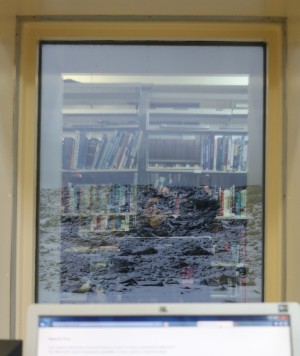
Me in the library, trying to get on the internet while reflected in a window (with books) through which you can see the snow – got all that?
Another unexpected development is an invitation to go on a hike outside the station that afternoon. I take that opportunity with both hands even though in theory I could spend some time sorting out my notes. There’ll be time to write about my adventures later!
Before then, on a more prosaic level, I explore the station’s laundry room, doing a load of washing and hanging up our sleeping bag liners in the warm room, where they’ll dry in no time at all. I sit with Andy from IT and he manages to get me partially online: Edge will work but not Firefox, go figure. I send a simple email, like it’s 1995. It’s still impossible to access my website, though, so I’m absolved of all guilt on that front. The wilds of Antarctica call.
Our hike requires us to dress once more in cold-weather gear and carry emergency packs, which I borrow from a helpful wintering volunteer. (Two, actually, thanks to a moment of confusion.) We load up and set off, much the same crew as stayed over at the hut last night, missing only Johan and Aki, from memory. We’re soon walking over snow untouched by human feet, and I’m crunching along with a huge smile on my face.
I feel as though we’re the first people to talk this way in the history of Antarctica–a fact that’s clearly untrue, given the number of antenna and so on in evidence. Also, our leader Simon describes how people take survival training and even cross-country ski around here sometimes. This is not a complete wilderness, but it still very special. And dangerous, as we’re occasionally reminded. Underneath thin bridges of ice lurk streams of running water. Step into one of those and you’d really know about it.
Snow falls periodically during our walk, but not heavily enough to be an impediment. (I wouldn’t have cared: it’s all a novelty to me.) We check out Clarke and Bailey Peninsulas, overlooking O’Brian’s Bay and Shirley Island. The scenery is gorgeous, particularly as all evidence of humanity falls behind us.
Foolishly, I left my good camera behind, but my iPhone did a pretty good job. The very first image from this series of blog posts is a panorama taken on this expedition. Below are some more. I urge you to click on them to see the images in greater resolution. Not the same as being there, but it’ll give you an idea of how extraordinarily rich this landscape is. Where some people see bleakness, I see endless potential–for beautify, for change, and even for life, albeit of a different kind than the sort we’re used to.

We visit the legendary Love Shack, where couples go for privacy (I think; people are understandably coy about discussing this aspect of station life). Along the way, we chat about the best ways to knock out everyone on the station, if, say, you were in a thriller novel–and why you might want to do such a thing. (My mind has been working.) Expeditioners, it turns, are surprisingly interested in this subject. The discussion is lively and inspiring.
We walk in a long, wide loop. On our way back, we stop to admire the closest penguin colony to Casey, which can be reached by an ice bridge when the weather is cold enough. But not today. Still, we see a seal, complete with the poop it ejected before surfacing to digest.
While everyone else gawps at the wildlife (you can watch a video of said wildlife here), I admire some fascinating rocks. They’re amazingly colourful, and I love the way stone splits in sheets here, after years of freezing and thawing. They look like giant 3D jigsaw puzzles, waiting to be solved.

We walk for three hours, but it seems to fly by. I’m incredibly hungry when I get back to base and eat god only knows what. Something very tasty, I’m sure, and lots of it. Lucky I’m burning about as many calories as I’m eating.
Filled with aurora afterglow, I don’t record anything in my dairy for the rest of the night. My lecture has been scheduled for the next evening, and there’s a lot of interest in that, thankfully. The night after we’ll be watching John Carpenter’s The Thing in the station “cinema” (a large room fitted out with big projector screen and comfy chairs) with the recent prequel as a B reel. I can’t wait. The night after that will be my last on station, which excites me somewhat less.
Tuesday
Best laid plans. Antarctica throws another spanner in the works this morning with Wednesday’s plane being delayed until Thursday and Friday’s plane (the one I’m supposed to be on) shifting to Saturday. Maybe Saturday. The forecast that far ahead is looking a bit rough.
I’m given a choice: take a chance on the Saturday flight, which would give me at least one extra night in Casey, or go home one day early, on Thursday. It’s clear which way Paul the station leader would prefer it to go. He has sixty people to get home on a limited number of flights before winter really sets in. If he can get me on a flight sooner rather than later, that’s one less thing for him to worry about.
I choose the selfish option first, and immediately feel bad about it. Station life is about working as a team. After consulting with my new friends, I call Paul and tell him I’ve changed my mind. I’ll go on Thursday, one day early.
So! I now have considerably less time to do all the things I’ve earmarked for closer attention, which includes going for a ride on a bike (they have them here, I’m told, quad and pedal-powered).
Outside it’s windy, gusting over 50 knots outside. At times it’s hard even to walk. But that’s what all the gear is for.
Ashleigh Wilson (Met), who’s been so generous to me all week, takes me on a tour of the hydroponic garden. It’s warm and humid and green and quiet in this tiny building; I can see why people come here to read. There’s a wide a variety of plants, from herbs to vegetables, including chillies but alas no Brussels sprouts.
Ashleigh walks me through the complicated series of tasks required to keep the garden alive and thriving, then leaves me alone to take lots of photos. They come out with a yellow wash, which I’ve done my ham-fisted best to correct. Hopefully people are better at hand-pollinating the flowers, which they do with a paintbrush.
(I’m embarrassed to admit that it’s not until around now that I realise that the potted plants dotted around the station are in fact plastic. No biohazards allowed, but the psychological benefits of green are probably mandated by a shrink up north . . .)
From there it’s with Jake to the science building, which lacks all evidence of mad schemes or superweapons (except for the one hidden at the back that I’m not supposed to mention), and then to walk around the remediation area, which I’ll tour properly tomorrow, when it’s less blustery.
After all that station exploration, I return to my room to gather up various things that need to be returned to Australia. At the departure induction, we’re appraised of our schedule, which begins tomorrow at 11am, with a “bag drag” (exactly what it sounds like) at the green store. Everything going in the hold needs to be weighed and checked in a day before we actually leave. I’ll start packing tonight. This consists mainly of deciding what I can manage without for a day and a half. My laptop is on that list.
After dinner, I’m honoured to join a long line of people who have delivered a lecture in Antarctica. Mine is about how I came to be here, and what I think I offer in return for the opportunity. It’s a packed house, which is very flattering. In lots of ways I’d rather it was the other way around. Everyone here is so interesting! But I think it helps to discuss why art should be represented, and what artists can give back to the whole Antarctica experience.
Australia and Antarctica are connected in surprising, subtle ways. Everyone should know more about it. Stories are one way to get that knowledge across, even if we lie a little to keep people hooked.
I talk a bit about Lone Soul Standing, the novel I’m officially here to research. Conversation quickly turns to the other novel I want to write, the one I have alluded to with various people in a piecemeal kind of way.
If Casey is a frontier town, then you could set a modern kind of western here, in which someone wanders into town, saves the day, then wanders out again (a la Jack Reacher). But every single part of that concept needs examination, because in Antarctica no one just wanders into town. Walking anywhere takes a huge amount of effort. Just getting to Antarctica is difficult.
Then there’s the fact that Casey is utterly unlike an ordinary town in lots of important storytelling ways. No money, for a start, so no banks to rob. That’s a big Western trope. So is the hooker with a heart of gold, and there are none of those here, either. There could be gold, though. Or oil. Or hell, as someone suggested, fresh water might one day be as valuable as any of these things. But are they worth killing for?
Conversation about this idea spills over into the bar afterwards, and across the coming days. I’ve yet to decide what I’m going to do with it all. I still don’t know, but it will be something brilliant. How can it be otherwise, after so much help?
As I head to bed, Andy Merlot (Comms) points out that there are two molting penguins visible from the external fire door directly by our bedrooms. I admire them in my tracky-dacks until my nipples threaten to shatter, then retire.
One more sleep.
I’m not ready to leave this wonderful place. Maybe I never will be.
Continued in Part Five: “Aftermath”
THANKS TO: Everyone in Casey. You know who you are!
More photos here.
For other blog posts about Antarctica, click here.



